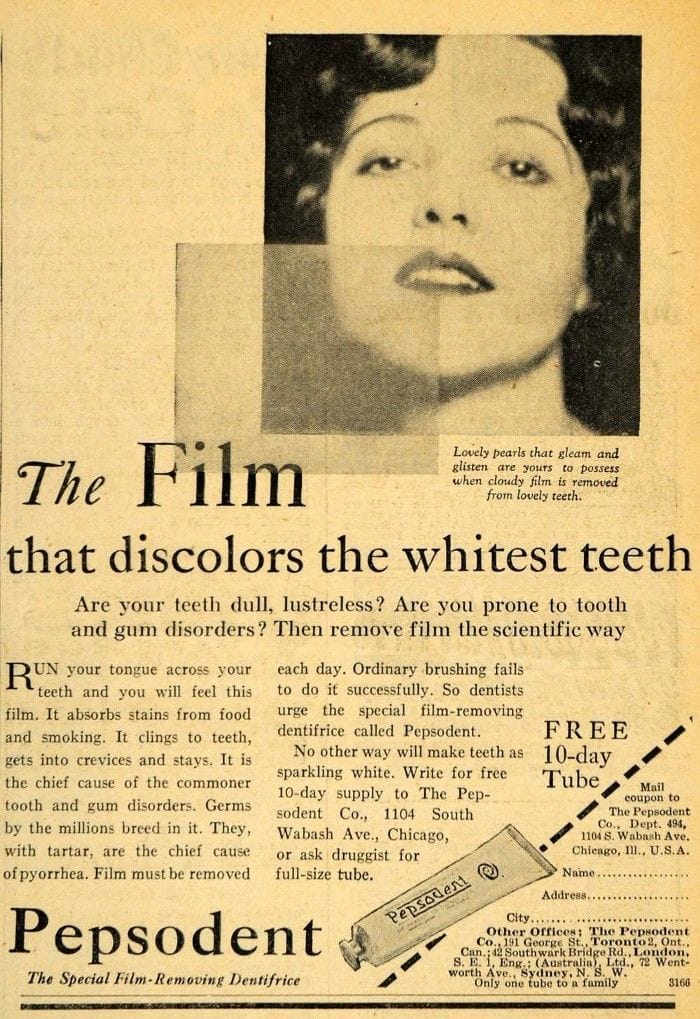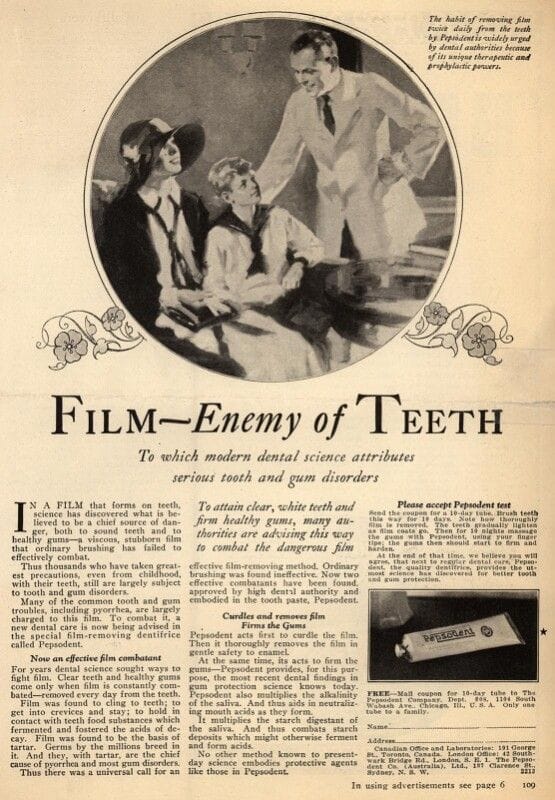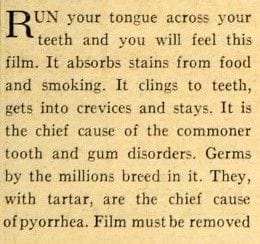Long-Lasting Lessons from Claude Hopkins Most Successful Advertising Campaigns (PART V)
Pepsodent Toothpaste Campaign
At a time when almost no Americans brushed their teeth, how do you sell toothpaste?
You contact Claude Hopkins, the man who made Schlitz the number one selling beer in America and Palmolive the world’s best-selling soap.
Pepsodent, an unknown toothpaste, was the greatest success of his career.
Not only he got Americans to brush their teeth daily, he also became a millionaire.
It seems the perfect place to end this series about his most successful advertising campaigns.
Let’s see how he did it.
Advertising Project - Pepsodent Toothpaste
The Product
Pepsodent toothpaste
The Campaign
Before World War I, almost no Americans brushed their teeth, which made selling toothpaste a challenge.
First, people had to see the benefit of brushing their teeth, then use your toothpaste on daily basis.
It was a great endeavor that started with something as simple as knowing the product inside out.
Sometimes this means reading dull book after dull book written by dental authorities. It also means finding the big idea for your advertising campaign.
For the Pepsodent campaign, the big idea was, “the enemy of your teeth is a viscous film.” The film was the dental plaque. It made your teeth look "off color" and invited decay and gum troubles. The solution: use Pepsodent to remove the film and get whiter teeth and healthy gums.
The focus on removing the film from teeth remained part of the Pepsodent ad strategy for many years.


The advertising campaign was based on three fundamentals:
- Offer a benefit. Pepsodent removes dental plaque so you can have sparkling and beautiful white teeth.
- Paint a picture with words. The initial ads made people realize they had something in their teeth that should not be there. It made them conscious of the problem by doing a simple test, "run your tongue across your teeth and feel the film."

- Give a free sample to try the product. Let them try the product and see the results. Almost every early Pepsodent ad emphasized a 10-day tube free to try the product. It was what worked best. The ads asking to buy the product didn’t work, neither did the ones urging to send ten cents for a sample.

Three weeks after the beginning of the campaign, the product demand exploded. Within a decade, Pepsodent was one of the top sellers around the globe.
The campaign was not without controversy.
At that time, it was usual for hygienic or pharmaceutical products to make promises they could not keep. Or base the entire campaign on science that did not exist.
Take a look at some of the claims that appeared in several ads:
- All statements approved by High Dental Authorities.
- Dental authorities subjected Pepsodent to every form of clinical test.
- A Scientific Product - Sold by Druggist Everywhere.
- Science has found the reason(for tooth troubles). It lies in a film. That causes most tooth troubles (such as dental decay and pyorrhea)
- Leading dentists everywhere began to advise it.
- Able authorities have proved these methods effective, by many careful tests.
What did dental authorities have to say about all this?
Real dental authorities did, in fact, several tests. In 1917, the headline “Pepsodent Devoid of Scientific Merit” appeared in the Michigan Dental Journal. The lead researcher behind the study explained that Pepsodent couldn’t eliminate the film on the teeth as it claimed to do.
It could have been a major setback. If something like this were to happen today, the campaign will stop. But back then, it was ignored. Claude's team knew their target audience read the Ladies Home Journal, not dental journals, so why bother.
The misleading advertising continued, going as far as claiming that their toothpaste could prevent grave diseases.
Lessons Learned from the Pepsodent Campaign
- Using the right appeal is crucial to the success of any advertising campaign. The Pepsodent campaign could be approached from two different angles:
- The preventive angle. Use Pepsodent to prevent cavities.
- The beauty angle. Use Pepsodent to have a beautiful smile.
In Claude's experience, prevention didn’t work so well. People will do everything to fix a problem but nothing to prevent it. He chose the beauty appeal. - Don’t rely on your experience or on guessing. Test on a small scale before launching a national or international campaign. The first 5-10 years of Pepsodent marketing produced a great variety of ads where they tweaked copy and imagery to see how their consumers responded. From this campaign, Claude learned hundreds of ways to not advertise toothpaste.
- Give before you take. Pepsodent ads didn't mention the product was for sale or the price. The goal of the ads was to prove their target audience what the product could do for them.
- Force distribution to introduce a new product to the market. Sell the product to the consumer, and the dealer will supply the demand.
Here is the complete Claude Hopkins successful campaigns series:
- Long-Lasting Lessons from Claude Hopkins Most Successful Advertising Campaigns (Part I) - The Cotosuet Campaign
- Long-Lasting Lessons from Claude Hopkins Most Successful Advertising Campaigns (Part II) - The Schlitz Beer campaign
- Long-Lasting Lessons from Claude Hopkins Most Successful Advertising Campaigns (PART III) - Palmolive Soap and Shaving Cream Campaigns
- Long-Lasting Lessons from Claude Hopkins Most Successful Advertising Campaigns (PART IV) - The Puffed Cereals Campaign
- Long-Lasting Lessons from Claude Hopkins Most Successful Advertising Campaigns (PART V) - The Pepsodent Toothpaste Campaign
